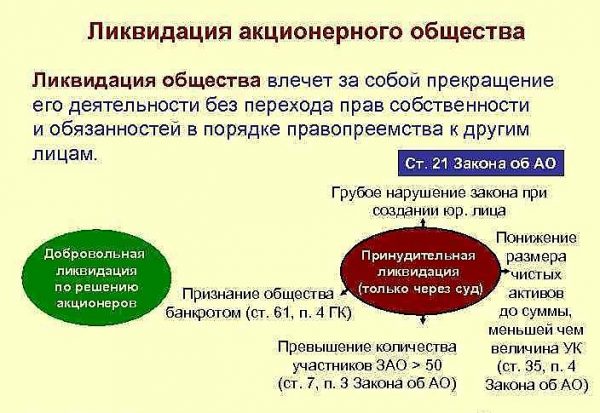The modern economy is characterized by a high rate of business process changes, and the alternation of periods of rise and fall. In such circumstances, the use of organizational, structural and legal changes as a management tool plays a key role. Reorganization and liquidation of the Company provides the following capabilities and contributes to solving business problems.
reorganization of tasks
 The choice of method depends on the reorganization of the goal. Features of liquidation and reorganization of joint-stock company is to select the method to achieve it:
The choice of method depends on the reorganization of the goal. Features of liquidation and reorganization of joint-stock company is to select the method to achieve it:
- for the creation of new businesses using the selection of the company or merger;
- to eliminate suitable option of joining the organization (It can also be used fusion or separation).
- access to new markets can be achieved by a merger of two or more enterprises or join one of them to another;
- share a few lines of business, reduce tax costs or redistribute the assets of the company will help the division or separation from her new organizations.
If you plan on reorganization and liquidation of the company, bring the issue to the consideration of the meeting may be the executive management body. Take such a decision can be an absolute majority (from 75%).
Regardless of the manner of reorganization, to the newly created company transfers part of the equity of the reorganized companies. Buyers of the securities - the shareholders of the company reorganized.
During the reorganization of the shares converted. Consequently, the issue of new securities must pass before it started.
Legal regulation of reorganization and liquidation of joint stock companies implies observance of the principle of succession. Newly created organizations assume the reorganized companies the rights / responsibilities. This order is fixed one of the documents:
- transfer deed (attachment / fusion);
- separation balance sheet (selection / partition).
This is the main difference between the ways of creating companies - through the establishment and reorganization.
Mergers and acquisitions
Both methods involve the reorganization:
- a voluntary procedure for - only by a decision of owners or management body (determined by the charter);
- Capital consolidation of the reformed enterprises;
- transfer of rights / responsibilities of companies, are to be eliminated, to their successors.
The difference lies in the composition of businesses, cease their activity. At the confluence of the combined companies to be liquidated, and in the case of accession - all, other than the acquiring company.
With the reorganization of the company through the merger / merger offering made:
- their conversion;
- exchange for securities.
 If in the course of reorganization through merger it found evidence of cross-shareholdings, they are to be repaid and are excluded from the conversion process.
If in the course of reorganization through merger it found evidence of cross-shareholdings, they are to be repaid and are excluded from the conversion process.
The State shall supervise the conduct of merger / merger transactions, to prevent the formation of monopolies.
The Antimonopoly Committee requires obtaining permission for such a reorganization in the case of the merging companies exceeded the amount of consolidated assets 100 000 MROT, and sending notification when exceeding 50 000 MROT.
Isolation and separation
Division is usually called method of reorganization, which resulted in one company ceases to exist and create at least two new. The process is accompanied by:
- section of the main assets of the enterprise;
- retaining the original composition of the owners;
- transfer of rights / duties of the reformed entities to newly created businesses.
Isolation - derivative of the split form of transforming society. The resultant company becomes the owner:
- part of the initial assets of the organization;
- of her rights / responsibilities.
A distinctive feature - no need to address the core of the enterprise. Placement of securities is carried out:
- conversion into shares of the company, formed after isolation or separation;
- purchase shares allocated by the donor community;
- distribution of securities allocated among the co-owners of the company reorganized company.
Reorganization and liquidation of the company by splitting / separation may be compulsory. The initiator of the procedure is a frequent speaker Antimonopoly Committee.
the possibility of transforming
To change the organizational / legal status of the company may be converted into other businesses (st.104 GK RF). Usually occurs in the reorganization Ltd.. Two other forms - business partnership and cooperative production are rarely used. Placement of shares held by:
- sharing of members' shares (shares, of shares) converted on a securities created JSC;
- exchange of shares into shares (pai) the newly established organizational and legal form.
Changing the legal form of a non-public company to a public not a transformation.
The order of elimination
 Creature, reorganization and liquidation of the company comes under the decision of the owners. Reasons for elimination can be different - from the end of the period of activity to a prolonged absence of transactions. Additional reasons for the elimination of the economic entity:
Creature, reorganization and liquidation of the company comes under the decision of the owners. Reasons for elimination can be different - from the end of the period of activity to a prolonged absence of transactions. Additional reasons for the elimination of the economic entity:
- the execution of works and services, prohibited by law;
- work without a license;
- financial insolvency;
- violation of the law in the course of creation and registration of the company;
- maintenance activities in gross violation of the law.
The decision to liquidate the company takes the court. Its responsibility also includes the appointment of a liquidator.











